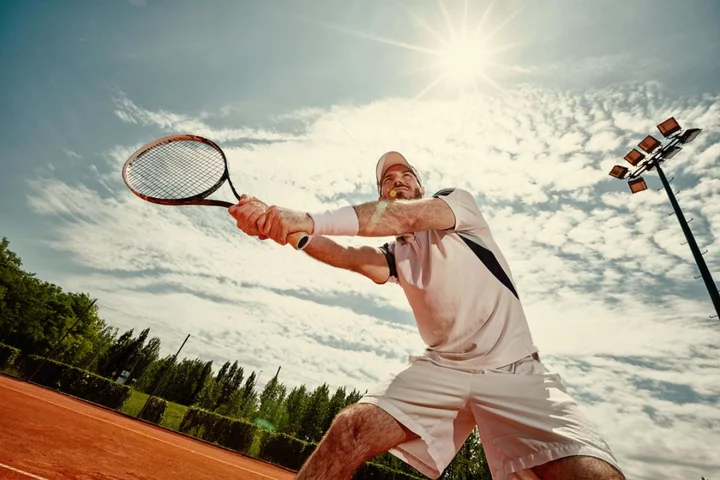
How tennis could be harming your body – and why it does you good
With Wimbledon underway and Nick Kyrgios already out due to injury, is tennis actually any good for you? Every tournament brings fresh injuries into the public eye, but the sport’s praises are often sung by fitness fans all over the world. So, how does it weigh up health and safety-wise? Is it worth investing some time in the sport if you enjoy Wimbledon? Tennis elbow The most common injury in tennis is tennis elbow, says Lucy Macdonald, physiotherapist at Octopus Clinic, and it’s something which has affected the likes of Andy Murray and Venus Williams. “Tennis elbow is the generic term for pain in the elbow, normally where irritation of the tendon runs over the elbow.,” she says. “It is often caused by a sudden overload on a tendon, in a way it is not used to, and it cannot cope with the forces that are on it. Treating it involves modifying what you are doing. “It can also be caused by other racket sports, and even things like breastfeeding a baby or cutting hedges and gardening,” she explains. But, it isn’t the end of tennis dreams. You can treat it. “Do not completely rest, modify the load going through the elbow, reduce the frequency and longevity of playing tennis, but things like physical support and tape can also help. “Changing your technique to take pressure off the tendon can help,” Macdonald explains. “The long-term treatment is to gradually build up the resilience of the tendon – a top spin stroke adds the most pressure – and alongside that, use static contractions – exercises that are just contracting the muscle, holding it and then relaxing.” Wrist injuries Kyrgios has pulled out of Wimbledon already, due to a wrist injury. “People may get wrist injuries if they fall and fracture the wrist. Or if they get a repetitive strain injury – if you use your wrist a lot in terms of the strokes you use with a lot of topspin – you can get some overuse and cause a flare up,” says Macdonald. Ankles and knees “Being on a slippery court, it can be easy to go over on your ankle,” she continues. “It happens in a lot of sports, if you’re running for a ball or trying to change direction. “You might get some knee problems, as they take such a hit generally with any propulsive sport – you get wear and tear on the knees, and sudden twists could impact your medial meniscus. Strength training is the best thing for that.” The benefits Should you be worried about all these injuries if you want to start playing, though? “The main cause of injuries in tennis is the sporadic nature people play it. If they suddenly go and play once every few months, the body is not used to the movements required in tennis, ” Macdonald notes.“You may suddenly run across the court and strain your calf or rupture your Achilles, because you haven’t run in months. “If you play it regularly and are consistent with the amount you play, it can be really beneficial,” she says.Any exercise is good, but the social aspect of tennis is hugely motivating, if you’re meeting up with three friends to play tennis, you have to show up – it gets you exercising regularly if you do it consistently. Tennis is beneficial for “increasing your heart and breathing rate, which is really good for your cardio and respiratory system. It keeps the range of motion in your shoulders, improves your balance with direction changes, and reduces your risk of falling,” says Macdonald. So, don’t let the risk of injury put you off. “There are so many positives that outweigh the negatives. Exercise, in general, extends your life span, and every illness out there is reduced by doing exercise. Even though it may have some impact on our musculoskeletal system, it is overwhelmingly positive for your mental and physical health.”
2023-07-04 19:51

This is how Novak Djokovic is preparing to win Wimbledon
Tennis won Novak Djokovic over when he was just four years old. Since then, the Serbian professional tennis player established himself as a reigning men’s champion. In July 2006, he won his first Association of Tennis Professionals (ATP) event, and reached the semi-finals at Wimbledon and the French Open a year later. The 36-year-old also advanced to the finals of the US Open in 2007, but lost in straight sets to the former Swiss professional tennis player Roger Federer. He managed to win his first Grand Slam tournament at the Australian Open and was awarded a bronze medal at the 2008 Beijing Olympics. Though Djokovic’s performance has plateaued at some points, his hot streak has continued over the last 16 years. He claimed his 21st Grand Slam championship after winning Wimbledon in 2022 and gained his 10th title at the Australian Open, crowning both him and Rafael Nadal with the most Grand Slam men’s singles championships. With the 2023 Wimbledon Championships in full swing until July 16, how will Djokovic prepare himself both mentally and physically to win? Diet Djokovic starts his day with raw celery juice — which has anti-inflammatory properties – and sometimes drinks it before, during and after matches. Celery is about 90% water, so it’s great for hydration first thing in the day, especially when you don’t feel like chugging down a glass of water. On other occasions, he drinks the green goddess smoothie, “which is a load of green things chucked in and blended. In the food industry, you can get green goddess dressings, sauces and juices, which all have kale, spinach, peas, mint, cucumber, apple and spirulina powder all blended into one”, says celebrity private chef Ethan Russell. And for breakfast, Djokovic would normally eat a power bowl — it’s got a lot of healthy fats, grains, and fruit in it — or have it as a snack before exercising. The clear number one rule is being gluten and dairy-free. “It’s a choice many athletes make, especially if they want to feel and perform their best. Gluten and dairy can cause irritation,” Russell says. There are so many different dairy and protein alternatives at the moment, such as coconut, soy and almond. “The bowl has different types of grains, gluten-free granola — with pumpkin seeds and goji berries — then a low sugar style muesli,” he adds.“If you are an athlete and trying to keep your sugar low, you can opt for dairy-free yoghurt and manuka honey, which is quite expensive and very sought after, with its anti-inflammatory properties. People use it in food and skincare, making it a super food. The bowl is then topped with blueberries and strawberries, packed with natural sugars.” Warming-up Djokovic would usually start warming-up with his physiotherapist, then move onto to mobilisation and movement exercises, to minimise the risk of major injuries. Warm-ups can be anything from the running man, squat reaches to the sky and lunge rotations, all of which encourage great blood circulation. A match can last one and a half hours, and there are so many things to manage on match days, according to Mark Taylor, who coaches British tennis player Ryan Peniston and also works at the Junior Tennis Coaching academy. “They play all year round and often under immense pressure. It’s why I also work with a sports psychologist,” he says. Mindfulness Djokovic is heavily into mindfulness, and might begin his day with silent meditating — especially if he’s got an important game to focus on — in a grounded way, to promote mental clarity, calm focus and energy. “Most of us find it difficult to sit still,” says Loren Peta, yoga teacher and personal trainer. “But gentle movement and box breathing — where you draw a box with your mind’s eye to help you stay present — is a great way to transition from a state of doing to state of being.” Whilst in conversation with former Spanish tennis player Alex Corretja at the The House of ASCIS event last Friday, Djokovic opened up about his mental health and wellbeing. “If we are talking about mental strength and preparation, and how it affects performance, I feel like half of the work is already done before you step out on to the court – also known as the battlefield,” Djokovic said. “It’s why I try to only peak at the biggest tournaments and take more time than I used to, to get my mind and body into perfect harmony. My body is responding differently than it was 10 years ago, so I have to be more specific with my preparation, work, training and recovery. I believe in a holistic approach to this sport, and everything else in life. “It’s about everything you do, eat, the relationships around you, how you perceive yourself, the traumas and emotions that are suppressed in you. I know for me, if I suppress something, it will always surface on the court. The more you put these things aside, the bigger the monster will become. “If you fail to prepare, it’s going to be a difficult mountain to climb during the match. Tennis isn’t a sprint, it’s a marathon as well.” Getting the right footwear There are certain things that are important to keep in your kit. But for Djokovic, his racket and shoes are the two most important items for every tennis player, especially at his level. Good shoes adapt to the way a tennis player moves their feet, to ensure the right support and exact comfort can be added, if required. For example, improved extra heel cushioning and ankle support. “The details [are important],” said Djokovic. “Every single thing matters. How you move, how you feel with your racket and shoes. You need to be comfortable with what you are wearing, because it’s going to help you perform and move better. “I probably move differently to most of the guys out there – even on grass, I slide. [So I need] really flexible shoes that allow me to stop when I need to stop, and change directions when I need to change directions. It can’t be too light or too heavy.” Read More Charity boss speaks out over ‘traumatic’ encounter with royal aide Ukraine war’s heaviest fight rages in east - follow live Money-saving ways to garden on a budget 8 budget-friendly ways to juggle childcare and work during holidays Dior’s couture show was the epitome of quiet luxury
2023-07-04 16:48

8 budget-friendly ways to juggle childcare and work during holidays
Idyllic images of happy children playing in sunny gardens during the summer holidays aren’t so easy to turn into a reality when you’re a working parent. Instead of wondering how full to fill the paddling pool, working mums and dads are more likely to be doing their sums about paying for the childcare they need so they can work as their kids enjoy the summer holidays. Emily Pritty, joint head of legal advice service at the charity Working Families, points out that its recent research found four in 10 low-income families have gone into debt to pay for childcare, nearly half have had to reduce their hours, and a fifth have even quit their job to manage childcare. “The summer holidays are a source of stress and anxiety for many working families whose work situation doesn’t allow them any flexibility to manage childcare and who can’t afford the additional childcare costs,” she says. “School holidays are the pinch point for so many working families with school-aged children, as the usual pattern of caring and routine changes, and the demands of work don’t reflect this.” But there are ways to make summer childcare more affordable for the UK’s 17.5 million working parents and carers, says Sabine Kobayter, chief marketing officer at Pebble, which connects parents with childcare and activity providers. “The summer holidays can be really hard for parents who are trying to juggle work and childcare – while also trying to feed hungry minds with activities that will stimulate children,” she says. “There’s a huge variance in the cost of finding childcare, and trips out as a family can quickly add up. The good news is there are many solutions to help find affordable ways to keep children entertained whilst spinning work plates too.” Here are budget-friendly summer childcare solutions suggested by Kobayter and Pritty… 1. Use holiday camps From sports camps to street dance, drama, academic and cookery, holiday camps start from £16.50 per day, says Kobayter. “Holiday camps are great as they often mirror the working day, and children can find camps that match their hobbies and interests,” she says, explaining that as holiday camps increase in popularity, the trick to getting a space is to book your child’s slot as early as possible. “This also allows you to plan your work schedule with the peace of mind knowing your children are being cared for, while doing something they love, and meeting new friends.” 2. Take paid or unpaid leave Many parents will have to use their annual leave to look after their kids over the summer, and if they don’t have enough left, unpaid leave is a statutory option, says Pritty. “The burden of taking unpaid time off does tend to fall more heavily on women due to the gender pay gap, as for family finances, often the decision is for the parent on the lower income to take the leave.” 3. Stretch out free childcare You’re entitled to 30 hours of free childcare in England, and Pritty suggests: “You could stretch your entitlement so you receive fewer hours each week but get the childcare during school holidays too.” Check whether your childcare provider will allow you to do this. 4. Get friends and family to help Many parents rely on informal networks of friends and family to help cover the gaps in caring throughout the year, and Pritty says: “This is particularly prevalent in school holidays, given the cost of holiday clubs and formal childcare. Parents often group together with friends to cover particular days and then reciprocate in a shared care arrangement.” 5. Use free kids’ activities “Not everything costs,” promises Kobayter, who suggests that if parents use annual paid/unpaid leave, or get friends and family to help with childcare, they keep subsequent costs down by searching for free activities local to them, and lock in days out as a family. “Museums, national parks, events in local parks – there’s a surprising amount available,” she says. 6. Try ad-hoc childcare Until recently, childcare needed to be locked in months, sometimes even years, in advance, says Kobayter, but now childminders and childcare providers are starting to enable ad-hoc bookings for parents in need. “As work becomes more flexible, childcare needs to as well,” she observes. “If you have a last-minute need to book childcare, all is not lost.” Pritty says the Family and Childcare Trust can provide details about your local Family Information Service, which will in turn be able to tell you about available summer childcare including childminders, nurseries, out of school clubs and any holiday schemes running in your local area. 7. Use vouchers if possible Childcare vouchers, tax-free childcare and the childcare elements of working tax credit and universal credit can all be used in holiday clubs, if the childcare is registered or approved, says Pritty, although she warns that not all childcare providers accept vouchers and they need to be signed up to tax-free childcare. You can check the types of childcare that you can get help with. 8. Check you’re getting the right financial help Pritty suggests parents check they’re getting the childcare support they are entitled to, by using this online calculator if necessary.
2023-07-04 15:49

Los Angeles officials urge beachgoers to stay away from poisoned sea lions amid Fourth of July celebrations
Ahead of the Fourth of July holiday, public health officials in Los Angeles are advising beachgoers to avoid sea lions that have been sickened by toxins from large algae blooms coating California beaches.
2023-07-04 04:18
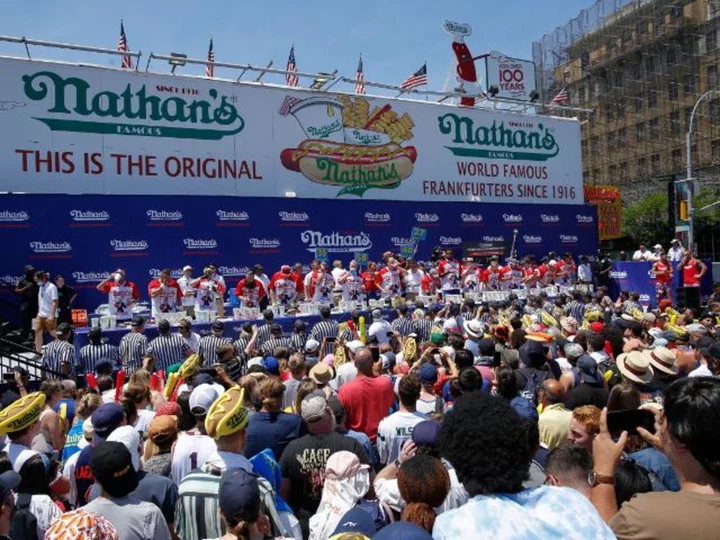
How to watch the Nathan's Famous International Hot Dog Eating Contest
Thousands of people will gather at Coney Island on Tuesday to watch competitive eaters scarf down mountains of sausages and buns during the annual Nathan's Famous International Hot Dog Eating Contest.
2023-07-04 02:22
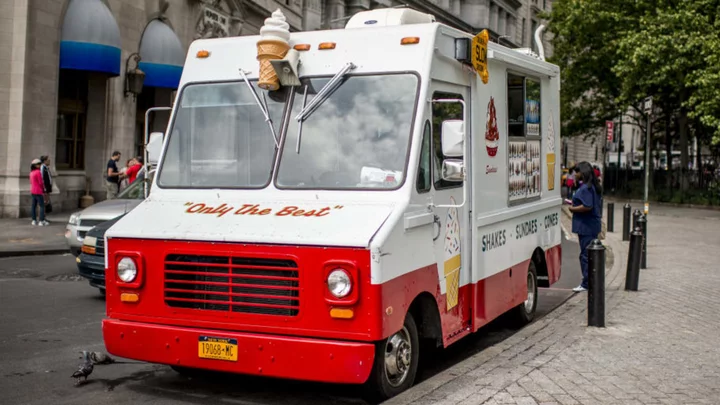
How to Track Down Ice Cream Trucks Near You
These online tools can help you locate the nearest ice cream truck in your neighborhood.
2023-07-04 01:16
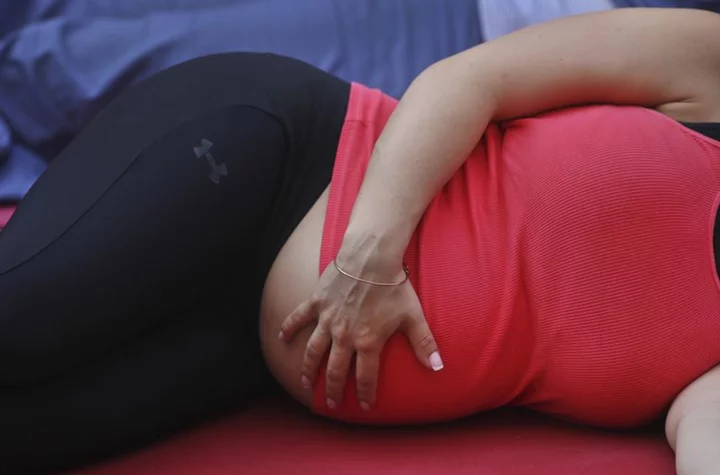
U.S. maternal mortality more than doubled since 1999, most deaths among Black women - study
By Nancy Lapid The number of U.S. women who died within a year after pregnancy more than doubled
2023-07-04 00:17
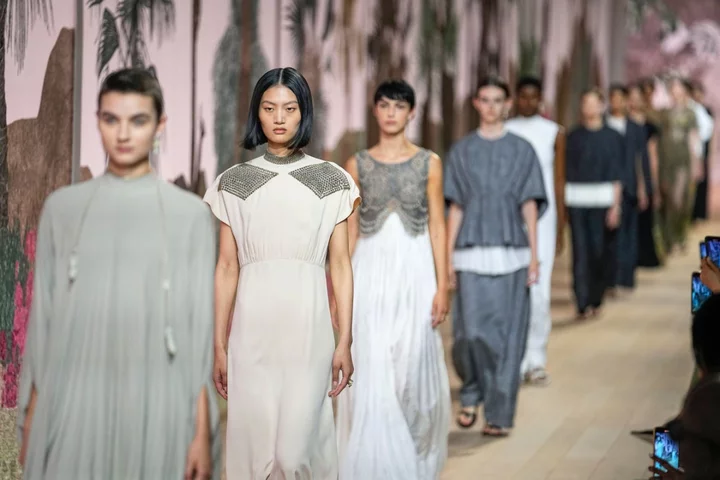
Dior’s couture show was the epitome of quiet luxury
Dior’s haute couture runway show in Paris saw the French fashion house tap into the most exclusive trend of the moment: quiet luxury. Brought to the fore by HBO television show Succession – which put the spotlight on the ultra-wealthy – quiet luxury is all about sleek, understated clothes that ooze elegance and wealth. Dior’s latest show took place at the Musée Rodin in Paris, a grand 18th-century mansion that displays Auguste Rodin’s work, most notably the famous sculpture The Thinker. In keeping with creative director Maria Grazia Chiuri’s continued dedication to feminism, the collection was themed around female narratives and representation in ancient mythology. The show opened with a model wearing a classic white gown with caped sleeves trailing to the ground. This set the aesthetic tone – models wore lots of long, flowing gowns in muted colours – mainly whites, earthy tones, navy or grey hues. There was lots of layering, sheer panels and flowing skirts – but everything was so precisely tailored that silhouettes were kept crisp and sharp. After all, this was a couture collection – seen as the pinnacle of craftsmanship, garments are one-of-a-kind and require a lot more skill, time and money to produce. While clothes were mainly left plain – as is the trend within quiet luxury – there was the odd subtle accent. Think intricate knotwork, heavy beading and floral appliques, adding to the overall feeling of wealth and glamour. The styling was kept simple – models wore their hair in low ponytails with a centre parting – and Dior made the case for a new trend: wearing one statement drop earring, instead of a pair. The show closed with a model wearing a heavily embellished caped gown – like a more formal, red carpet-ready version of the opening look. Celebrity guests on the front row also wore silhouettes and simple designs that felt like quiet luxury. Australian actor Elizabeth Debicki – who plays Diana, Princess of Wales in The Crown – kept things chic and French-inspired with her outfit, wearing a black beret with netting over the top, a simple white tank top and a black leather skirt. House ambassador Natalie Portman wore a white strapless gown with watercolour-style pastel accents. A familiar face on the Dior front row, actor Rosamund Pike had her hair slicked back, and donned a black dress with an off-the-shoulder neckline. At the end of the show, designer Maria Grazia Chiuri took a brief bow, her own outfit another prime example of understated luxury: a simple yet impeccably tailored navy suit. Read More Charity boss speaks out over ‘traumatic’ encounter with royal aide Ukraine war’s heaviest fight rages in east - follow live The history of royal fashion at Wimbledon Cardi B and Tracee Ellis Ross sit front row at Schiaparelli show in Paris Affected by someone else’s drinking? 3 key pieces of advice for loved ones of alcoholics
2023-07-03 23:27

Fourth of July: Air travel chaos resumes ahead of Independence Day
Extreme weather and storm threats pose continued challenge as Americans celebrate the Fourth of July.
2023-07-03 22:50

'The Witcher' Season 3's ball costumes are packed with hidden clues
The Witcher Season 3's standout episode of Volume 1 is one full of fabric, otherworldly
2023-07-03 20:19

From Princess Diana to Kate Middleton: The history of royal fashion at Wimbledon
Ties between Wimbledon and the royal family go back a long way. To 1907, to be precise, the first year that the Prince and Princess of Wales (who would become King George V and Queen Mary) attended the famous Championships. King George V later became patron of the All England Lawn Tennis and Croquet Club, a role now held by the current Princess of Wales. Kate Middleton’s outfits are pored over almost as much as the action on court, and looking back at royal appearances at the tournament we can see how fashion has evolved throughout the decades. Keep up with Wimbledon 2023 via our liveblog. As the iconic Championships begins today (Monday 3 July), a fashion expert talks through some key looks and what they tell us about the style of the era… King George V and Queen Mary During the first Wimbledon Championships after a four-year hiatus due to World War I, the 1919 women’s final was attended by King George V – who was known to dislike contemporary fashion – and Queen Mary. “When George arrived at Wimbledon, the hub of fashion inspiration for trendy Brits going into the Twenties and Thirties, he stood out like a sore thumb,” says Rosie Harte, author of The Royal Wardrobe. Queen Mary wore a fringed dress with a loose coat, hat and gloves, and carried an umbrella. “She, like other members of the royal family, felt pressure to fall in line with George’s conservative fashion preference,” Harte continues. “And so appears here dressed in a slightly dated, soft and cluttered outfit at odds with the trim tailoring and sleek silhouettes beginning to emerge in women’s fashion.” Queen Elizabeth II Queen Elizabeth II became patron of the All England Club in 1952, but only visited the Championships a handful of times. The first was in 1957 when she attended the women’s singles final, wearing a floral midi dress with white accessories. “Unlike the celebrities of their day, the most dutiful of Wimbledon-bound royals have often avoided pandering to the tennis aesthetic when styling themselves for an appearance,” says Harte. “Even as a young Queen at Wimbledon, Elizabeth was always more fond of an outfit that read homely British romance rather than the wardrobe of the modern woman.” The monarch returned to the tournament in 1977, donning a pink coat dress and hat, and in 2010, wearing a similar ensemble in aqua blue. “Each appearance followed the rubric of the Queen’s royal uniform which, as the years went on, became more and more regimented,” Harte says. “Whether she was on the green or sat in a sea of spectators, the eye needed to be drawn to the Queen through the use of vibrant colours that do not typically feature in the Wimbledon setting.” Diana, Princess of Wales Tennis fan Diana attended Wimbledon more than a dozen times during the Eighties and Nineties, during which time her personal style evolved considerably. “Going into the Nineties, the Princess of Wales was under no illusion that her marriage was the fairytale it had initially been framed as,” suggests Harte. “Consequently, the frothy, fairytale elements of her wardrobe, inspired by the traditional looks of more senior royals, began to disappear.” Floral frocks and roomy sailor dresses made way for more structured and tailored looks. Harte says: “Her white pleated skirt in 1991 embodied an elevated tennis skirt, and in 1995, her pale suit jacket with sunglasses folded over the collar set her apart as a sleek modern woman.” Kate Middleton Another big tennis fan, Kate has been snapped in the audience at Wimbledon as far back as 2007, but her first memorable fashion look came in 2012, a year after she married the Prince of Wales. Kate donned a seemingly tennis-inspired knitted dress from Alexander McQueen (the label that made her wedding dress) with a drop-waist and blue accented cuffs and hem. “She radiated the essence of the iconic pre-war tennis star – an aesthetic largely rejected by the royal family,” says Harte. Taking over from the late Queen as patron in 2016, Kate has continued to reference tennis colours over the years with green and white dresses, and in 2022 opted for vintage-inspired looks. “Last year saw her attending Wimbledon in various outfits that used cut, colour and accessories to reference the fashions of the daring, modern woman who emerged in the 1920s and Thirties,” says Harte. “Her bright yellow Roksanda IlinÄić frock was the most subtle of these, but the vibrant colour was uncompromising, making her an unavoidable figure at the event.” Read More Charity boss speaks out over ‘traumatic’ encounter with royal aide Ukraine war’s heaviest fight rages in east - follow live The Idol should have been about modern cults rather than Tedros’s weird kinks Stanley Tucci recalls trying to break up with wife Felicity Blunt over 21-year age gap Plans for Prince Andrew to move into Harry and Meghan’s former home ‘quietly shelved’
2023-07-03 19:55
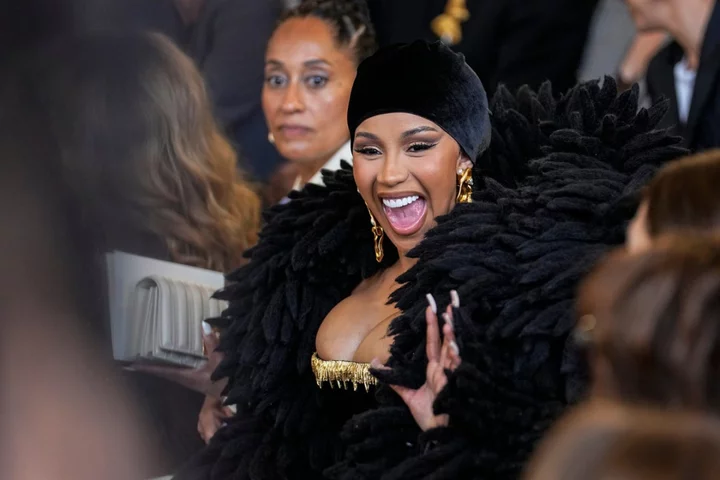
Cardi B and Tracee Ellis Ross sit front row at Schiaparelli show in Paris
Cardi B attended the Schiaparelli Haute Couture show in Paris wearing a glamorous outfit from the Italian fashion house. The rapper sat front row at the opening show of the autumn/winter season, held at the Petit Palais, in a black gown with gold trim and a huge fluffy black jacket. She accessorised her look with a black head wrap and surreal gold earrings – a Schiaparelli signature. American actor Tracee Ellis Ross sat next to Cardi B on the front row, wearing a blue and white shirt and matching trousers. Other fashionable celebrities in attendance included Game Of Thrones star Gwendoline Christie, French actor Philippine Leroy Beaulieu (who plays Sylvie in Netflix series Emily In Paris) and fashion influencer Chiara Ferragni. The opening runway look – a sculptural black and white skirt suit with oversized collar, cuffs and hem – set the tone for the collection, which was all about volume and texture. Creative director Daniel Roseberry sent out a variety of ensembles in the label’s signature black and gold colour combination. Black and white winter coats came with voluminous sleeves and collars, or were made from thick, shaggy fabric. A gigantic metallic puffer coat was teamed with strings of equally enormous gold beads. “Blurring the lines between the real and the unreal,” was how the collection was described in a preview post on Instagram. More vibrant looks included a pastel-toned, long-sleeved dress that looked like it had been painted on the model. Flashes of electric blue and turquoise appeared throughout the show. This season saw models adorned with statement necklaces and huge bangles. The show concluded with glamorous evening looks, including a rust satin corset gown with a flowing tulle skirt modelled by South Sudanese-Australian model Adut Akech. Russian supermodel Irina Shayk closed the show in a diaphanous black gown and textured cape with electric blue lining. Always one of the big draws at Haute Couture Week, Schiaparelli has become known for its eye-popping catwalk designs, surrealist take on fashion and stellar front row. The label has recently been worn by stars such as Adele, Beyonce and Naomi Campbell. Read More Charity boss speaks out over ‘traumatic’ encounter with royal aide Ukraine war’s heaviest fight rages in east - follow live Affected by someone else’s drinking? 3 key pieces of advice for loved ones of alcoholics The history of royal fashion at Wimbledon How to be waterwise in your garden this summer
2023-07-03 18:53
